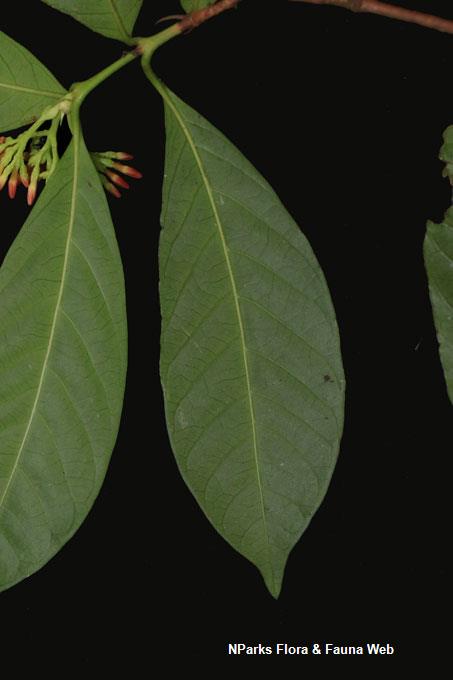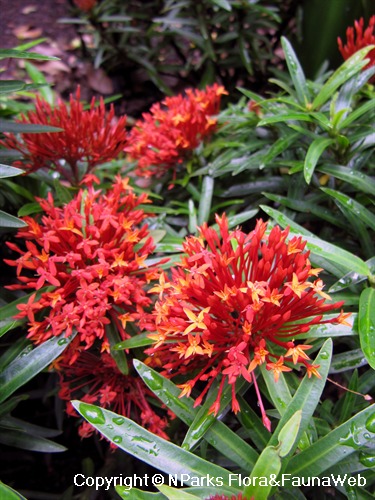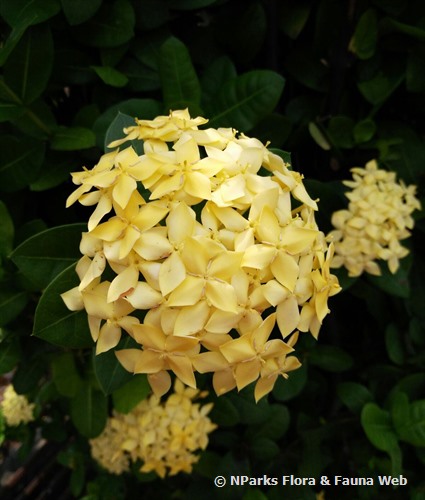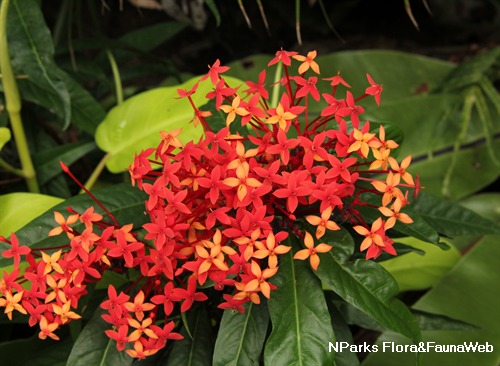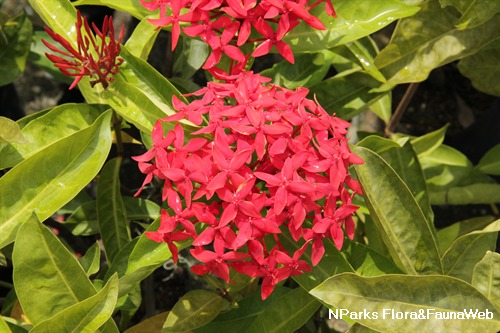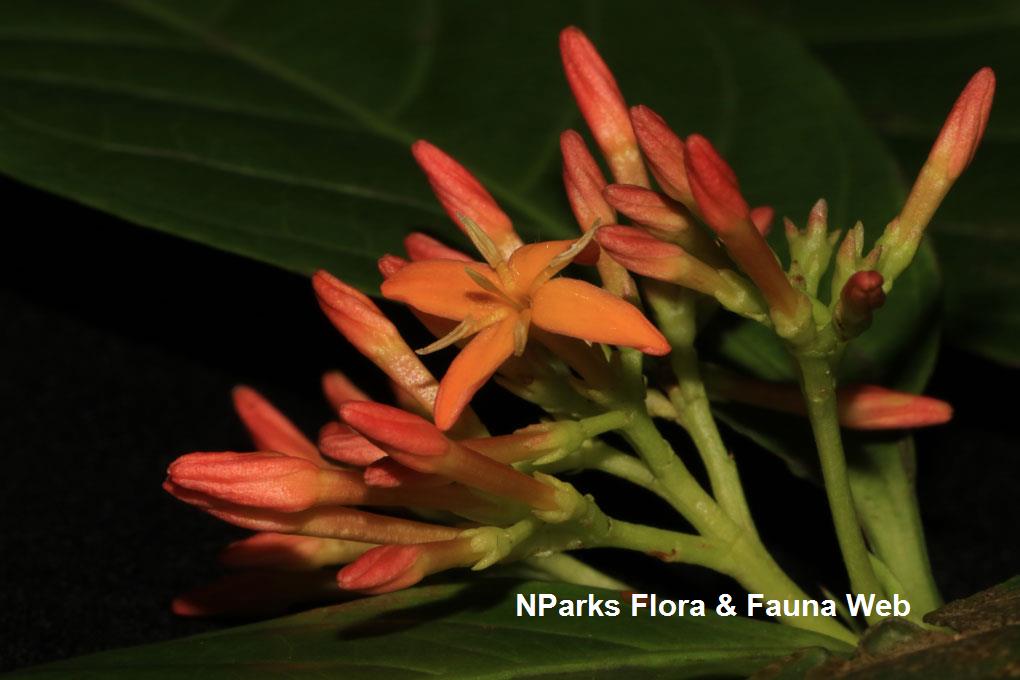
Back
Ixora concinna R.Br. ex Hook.f.
| Family Name: | Rubiaceae |
| Synonyms: | Ixora parviflora auct. non Vahl <1> |
| Common Name: | Jenjarum |
Ixora concinna or Jenjarum is an understorey large shrub to treelet native to Singapore. Growing to 8 m tall, it has elliptic to spoon shaped leaves with weakly looped veins. Flowers are fragrant, yellowish to pinkish-red, 4 narrowly elliptic, lance or linear lobes held on an inflorescence found near the tips of branches. The fruit is an almost round or slightly bilobed drupe holding 1 to 2 white, mottled in pink pyrenes. Upon maturity, the fruit matures from red to black.
Name
Classifications and Characteristics
| Plant Division | Angiosperms (Flowering Seed Plants) (Dicotyledon) |
|---|---|
| Plant Growth Form | Tree (Small (6m-15m)) |
| Maximum Height | 8 m |
Biogeography
| Native Distribution | Malay Peninsula, Sumatra, Borneo and Singapore |
|---|---|
| Native Habitat | Terrestrial (Primary Rainforest, Secondary Rainforest) |
| Preferred Climate Zone | Tropical |
| Local Conservation Status | Native to Singapore (Presumed Nationally Extinct (NEx)) |
Description and Ethnobotany
| Growth Form | It is an understorey large shrub to treelet that can grow to 8 m tall. |
|---|---|
| Foliage | Leaves are elliptic to spoon-shaped, 7 - 9 pairs of lateral veins weakly looped near the margins. The veinlets are faint on the lower surface. The leaves are held on a short petiole from 0.4 - 1 cm long. |
| Flowers | Flowers are fragrant, tubular with 4 narrow elliptic to lance or linear lobes, yellowish to pinkish-red resting on an inversed triangular base. The flowers have broad triangular to egg-shaped calyx lobes held on a multi-branched inflorescence found at the tips of branches. |
| Fruit | The fruit is an almost-round or slightly bilobed drupe, holding 1 - 2 pyrenes. Pyrenes are white, mottled in pink, consist of 1 seed each. Upon maturity, the drupe ripens from red to black. |
| Habitat | Occurs in lowland forests. |
| Cultivation | It can be propagated by seed. <2> |
| Etymology | The genus, Ixora dereived from ishvara, a deity in Sanskrit, the classical language of the Brahmans in India. The species epithet, concinna Latin, concinnus = elegant; referring to the inflorescences and slender corollas. |
Landscaping Features
| Desirable Plant Features | Ornamental Flowers |
|---|
Plant Care and Propagation
| Light Preference | Semi-Shade |
|---|---|
| Water Preference | Moderate Water |
| Plant Growth Rate | Moderate |
| Rootzone Tolerance | Fertile Loamy Soils, Well-Drained Soils |
| Propagation Method | Seed |
Foliar
| Foliage Retention | Evergreen |
|---|---|
| Foliar Modification | Stipule |
| Foliar Type | Simple / Unifoliate |
| Foliar Arrangement Along Stem | Opposite |
| Foliar Attachment to Stem | Petiolate |
| Foliar Shape(s) | Non-Palm Foliage (Elliptical, Obovate) |
| Foliar Venation | Pinnate / Net |
| Foliar Margin | Entire |
| Foliar Apex - Tip | Acute, Cuspidate |
| Foliar Base | Cuneate |
Non - Foliar and Storage
| Stem Type & Modification | Woody |
|---|
Floral (Angiosperm)
| Flower & Plant Sexuality | Bisexual Flowers , Bisexual Flowers |
| Flower Colour(s) | Pink, Red, Yellow / Golden |
|---|
| Flower Grouping | Cluster / Inflorescence |
| Flower Location | Terminal |
| Flower Symmetry | Radial |
| Individual Flower Shape | Salverform |
| Flowering Habit | Polycarpic |
Fruit, Seed and Spore
| Mature Fruit Colour(s) | Black |
|---|---|
| Fruit Classification | Simple Fruit |
| Fruit Type | Fleshy Fruit , Drupe |
References
| References | <1> Ridley, H.N. (1900). The flora of Singapore. Journal of the Straits Branch of the Royal Asiatic Society 33: 97. <2> Wong, K.M. et. al. (2019). Ixora. Flora of Singapore, vol. 13, pp. 138. Singapore: Singapore Botanic Gardens, National Parks Board. |
|---|
Image Repository
Others
| Master ID | 34430 |
|---|---|
| Species ID | 8843 |




